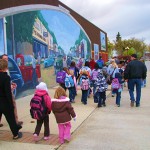-
Increased Physical Activity Levels for Children
Children and youth need to be physically active every day, for at least 90 minutes, for optimal growth and development, but more than half of Canadian children are not active enough. Regular physical activity offers numerous physical health benefits to children such as helping to build strong bones, strengthening muscles, increasing cardiovascular fitness, improving sleep and assisting in maintaining a healthy weight. Most parents would strongly agree that physical activity helps their children build self-esteem, increase concentration and improve learning, while direct links have been made to a reduction in depression, anxiety and fatigue and improved interpersonal relationships. Increasing the amount of daily physical activity, to reach a minimum of 90 minutes, can be easily reached by gradually increasing the time spent doing activity, such as walking or biking to and from school.
-
Taking Action on Air Quality
Idling (running your car for 10 seconds or longer) in school zones increases air pollution in an area where children spend a lot of time. In fact, air quality has been shown to be worse on streets where schools are located. In Manitoba, transportation accounts for over 30% of greenhouse gas emissions overall and almost 50% of individual household emissions.Walking or biking, instead of driving, for one or two short trips per week, can lead to positive environmental impacts and better air quality around Manitoba schools.
-
Increased Safety in the Neighbourhood

Every parent who drives their child to school adds one more vehicle to already congested roads, while removing their eyes from the street. This creates a downward spiral – the emptier the sidewalks become, the more parents may view them as unsafe. And with fewer parents monitoring their neighborhood sidewalks, there’s a concern that children who walk to school alone can become more vulnerable to the dangers of traffic, bullying, harassment or abduction. Having more people walk through our communities is a great way to reduce crime and take back our neighborhoods.
-
Reduced Traffic Congestion around Schools
With up to 50% of children being driven to and from school each day, vehicle speeds and dangerous traffic congestion have become a serious problem near schools. Children and adults who have to walk through this area are at a significant risk of injury. By reducing the number of cars traveling to and from schools and getting more children choosing active modes of transportation, everyone can enjoy safer streets.
-
Heightened sense of community
 Our increasing over-dependence on the car means that many children have limited opportunities during their formative years to experience both the people and the physical environment of their community. The decreased person-to-person contact among all community members also reduces community awareness and involvement. Children actively travel to school can feed their curiosity with a broader range of experience and thus develop a more diverse view of the environment and their community. As well, the establishment of a School Travel Plan often leads to changes in local physical infrastructure. These changes help create an environment that makes active transportation safer and more accessible to everyone in the community.
Our increasing over-dependence on the car means that many children have limited opportunities during their formative years to experience both the people and the physical environment of their community. The decreased person-to-person contact among all community members also reduces community awareness and involvement. Children actively travel to school can feed their curiosity with a broader range of experience and thus develop a more diverse view of the environment and their community. As well, the establishment of a School Travel Plan often leads to changes in local physical infrastructure. These changes help create an environment that makes active transportation safer and more accessible to everyone in the community.




Recent Comments